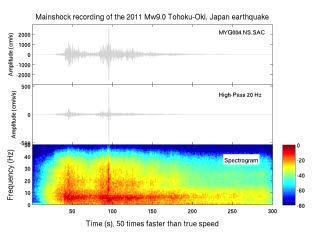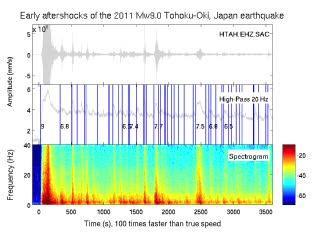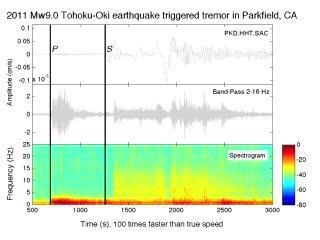
This recording was taken about 90 miles from the Japanese earthquake's epicenter. There are two distinct sound waves. Both are caused by the mainshock. A "pop" is heard 90 seconds (in actual time) after the main event. This pop wasn't recorded at any other nearby stations, leading Georgia Tech Associate Professor Zhigang Peng to believe that either the ground shifted immediately under the measuring station, or the hill slope where the station sits in helps to amplify the shaking. It was the strongest reading he found -- a ground acceleration of nearly three g.
(Photo Credit: Georgia Institute of Technology)

This recording of the 2011 Japanese earthquake was taken near the coastline of Japan between Fukushima Daiichi (the nuclear reactor site) and Tokyo. The initial blast of sound is the 9.0 mainshock. As the earth's plates slipped dozens of meters into new positions, aftershocks occurred. They are indicated by "pop" noises immediately following the mainshock sound. These plate adjustments will likely continue for years.
(Photo Credit: Georgia Institute of Technology)

In this recording of the 2011 Japanese earthquake, taken from measurements in California, the quake created subtle movements deep in the San Andreas Fault. The initial noise, which sounds like distant thunder, corresponds with the Japanese mainshock. Afterwards, a continuous high-pitch sound, similar to rainfall that turns on and off, represents induced tremor activity at the fault. This animation not only help scientists explain the concept of distant triggering to general audiences, but also provides a useful tool for researchers to better identify and understand such seismic signals in other regions.
(Photo Credit: Georgia Institute of Technology)
Source: Georgia Institute of Technology